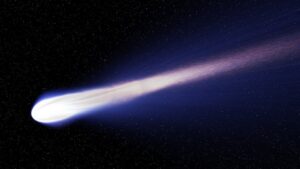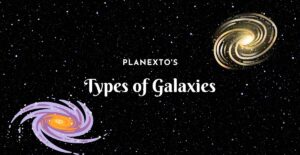Introduction
Comets, those celestial wanderers captivating our imagination for centuries, are much more than mere cosmic spectacles. These dazzling objects, often likened to celestial snowballs, comprise ice, dust, gases, and rocky material hurtling through space. Let’s delve into the enigmatic world of comets, unveiling their composition, journeys, and the profound impact they’ve had on our understanding of the universe.

What Are Comets Made Of?
Primarily composed of ice, dust, and volatile compounds. The core, or nucleus, is a conglomerate of water ice, frozen gases like carbon dioxide, methane, ammonia, and dust particles. As a comet approaches the sun, the heat causes these elements to sublimate, forming the striking tails we associate with them.
The Anatomy of a Comet
Comets boast distinct features. The nucleus, the heart of a comet, is relatively small, ranging from a few kilometers to tens of kilometers in diameter. It’s enveloped by the coma, a hazy cloud of gas and dust particles, which grows larger as the comet approaches the sun, illuminated by reflected sunlight. The breathtaking tails—a dust tail and an ion tail—extend from the coma, trailing behind the comet’s path due to solar wind and radiation pressure.
Comet Orbits and Journeys
Comets follow elongated orbits around the sun, categorized into short-period and long-period.
Short-period comets:
- These are the sprinters of the comet world, zooming around the Sun in less than 200 years.
- They hang out in the Kuiper Belt, a sort of icy neighborhood beyond Neptune.
- Think of Halley’s Comet, swinging by every 76 years, or Encke’s Comet, doing its loop every 3.3 years.
Long-period comets:
- These comets take their sweet time, with orbits spanning hundreds to thousands of years.
- They’re like the deep space adventurers from the Oort Cloud, this far-out place surrounding our solar system.
- These aren’t as regular visitors, and we often spot them when they decide to swing by the Sun. They’re kind of like the surprise guests of the cosmic party.
Historical Significance and Observations
Throughout history, these celestial bodies have evoked awe and fear. Ancient civilizations interpreted them as omens, with their appearances often linked to significant events. Halley’s Comet: Iconic celestial traveler with a 76-year orbit, dazzling Earth periodically with its bright tail and historic appearances, one of the most famous, was observed and recorded as early as 240 BC. Today, advanced telescopes and space probes allow us to study comets up close, unveiling their secrets and shedding light on the solar system’s formation.

Scientific Relevance
Studying comets provides invaluable insights into the origins of our solar system. These cosmic time capsules carry pristine materials unchanged since the early ages, offering clues about the conditions prevailing during the solar system’s formation. Scientists believe that these celestial bodies might have played a pivotal role in delivering water and organic compounds to Earth, potentially seeding life.
Popular Culture and Imagination
Comets have inspired art, literature, and cultural beliefs for centuries. From paintings depicting their ethereal beauty to stories portraying them as harbingers of change, these celestial bodies hold a mystical allure. Their appearances in science fiction often evoke wonder and fascination, reflecting humanity’s enduring curiosity about the cosmos.

The Future of Comet Exploration
Advancements in space technology have enabled missions dedicated to exploring comets. Spacecraft like Rosetta and Stardust have provided unprecedented data and images, revolutionizing our understanding of these cosmic travelers. Future missions aim to land on comets, collect samples, and conduct in-depth analysis, unraveling more mysteries.
Conclusion
In conclusion, these celestial bodies continue to captivate us, offering a window into the universe’s past and shaping our understanding of its evolution. Their beauty, scientific importance, and cultural significance make them celestial marvels worth exploring further. Remember, as we gaze at these celestial wanderers, we are not merely witnessing a spectacle; we are glimpsing the ancient secrets of our cosmic origins.
FAQs
Q: What Causes a Comet’s Tail?
A: A comet’s tail forms due to solar radiation, vaporizing the nucleus’s volatile materials and creating a glowing trail.
Q: Can Comets Hit Earth?
A: While collisions are infrequent and can potentially collide with Earth, although the probability remains low
Q: What Makes Comets Glow?
A: The glowing effect arises from ionization caused by solar radiation interacting with the comet’s coma and tail.
Q: Are Comets Dirty Snowballs?
A: Yes, they are often described as “dirty snowballs” due to their icy composition mixed with dust and rocky particles.
Q: Can Comets Hold Clues to the Origin of Life?
A: Studying these celestial provides insight into the early solar system’s conditions, potentially offering clues to the organic compounds and water crucial for life’s emergence on Earth.
Q: Are Comets Dangerous?
A: Despite their celestial beauty, pose minimal threat to Earth. Their trajectory and size determine their potential impact, with known cases of comet causing spectacular meteor showers.
Follow me on Quora for more queries








